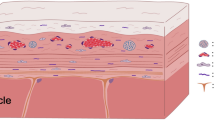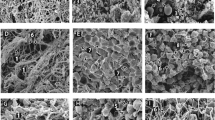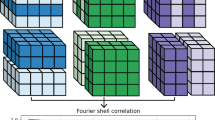Abstract
THE electron microscopic appearances of fibrin were first described by Hawn and Porter1 and Hall2, and these workers showed that in vitro fibrin had an axial periodicity of between 220 and 230 A. and a fibril width of approximately 150 A. Since that time, Levene3 and Still and Boult4 have investigated fibrin in pathological material and have shown that it possesses the same characters as artificially produced fibrin, and moreover seems to be bound in bundles which have a marked tendency to fold.
This is a preview of subscription content, access via your institution
Access options
Subscribe to this journal
Receive 51 print issues and online access
$199.00 per year
only $3.90 per issue
Buy this article
- Purchase on Springer Link
- Instant access to full article PDF
Prices may be subject to local taxes which are calculated during checkout
Similar content being viewed by others
References
Hawn, G. V. Z., and Porter, K. R., J. Exp. Med., 86, 285 (1947).
Hall, C. E., J. Biol. Chem., 179, 857 (1949).
Levene, C. I., Lancet, ii, 1216 (1955).
Still, W. J. S., and Boult, E. H., Lancet, i, 117 (1956).
Author information
Authors and Affiliations
Rights and permissions
About this article
Cite this article
STILL, W., BOULT, E. Electron Microscopic Appearance of Fibrin in Thin Sections. Nature 179, 868–869 (1957). https://doi.org/10.1038/179868b0
Issue Date:
DOI: https://doi.org/10.1038/179868b0
This article is cited by
-
A comparison of tinctorial and immunohistological methods for the detection of fibrinoid change and fibrin deposition in the kidney
The Histochemical Journal (1972)
-
Fibrin in hepatocytes
Die Naturwissenschaften (1967)
-
Elektronenmikroskopische Untersuchungen zur Gestalt und zum makromolekularen Bau des Fibrinogenmolek�ls und der Fibrinfasern
Zeitschrift f�r Zellforschung und Mikroskopische Anatomie (1967)
-
Thrombusbau und Thrombolyse
Klinische Wochenschrift (1964)
-
�ber das Sanarelli-Shwartzman-Ph�nomen (sog. generalisierte Shwartzman-Ph�nomen) des Menschen
Klinische Wochenschrift (1959)
Comments
By submitting a comment you agree to abide by our Terms and Community Guidelines. If you find something abusive or that does not comply with our terms or guidelines please flag it as inappropriate.



